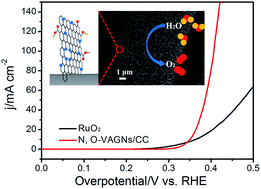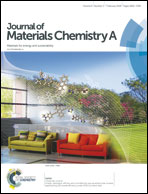Nitrogen-doped, oxygen-functionalized, edge- and defect-rich vertically aligned graphene for highly enhanced oxygen evolution reaction†
Abstract
Graphene-based electrocatalysts have been extensively developed as a metal-free alternative to noble metals for the oxygen evolution reaction (OER). Till date, however, their OER performance is far from satisfactory in terms of both activity and stability due to low amount of active sites and a severe aggregation/restacking effect. Herein, we developed the in situ growth of nitrogen-doped, oxygen-functionalized and edge/defect-rich vertically aligned graphene nanosheets on the surface of a carbon cloth (N, O-VAGNs/CC). The separate graphene nanosheets fixed to the surface of the carbon cloth could effectively avoid aggregation. In addition, the vertically aligned morphology provides a highly superficial area and open space, resulting in maximally exposed active sites and unhindered gas transport. Moreover, compared with undoped graphene, the N, O-VAGNs/CC possesses numerous functional groups, abundant defects and active-edges, which are favorable to OER activity. Impressively, this graphene design drastically enhanced OER activity with an overpotential of 351 mV and a Tafel slope of 38 mV dec−1 in alkaline solution, which is superior even to the state-of-the-art RuO2 electrocatalysts, indicating remarkable stability and durability in alkaline media. This study may provide an insight into the design and fabrication of alternatives to noble metal-based catalysts for the OER.



 Please wait while we load your content...
Please wait while we load your content...